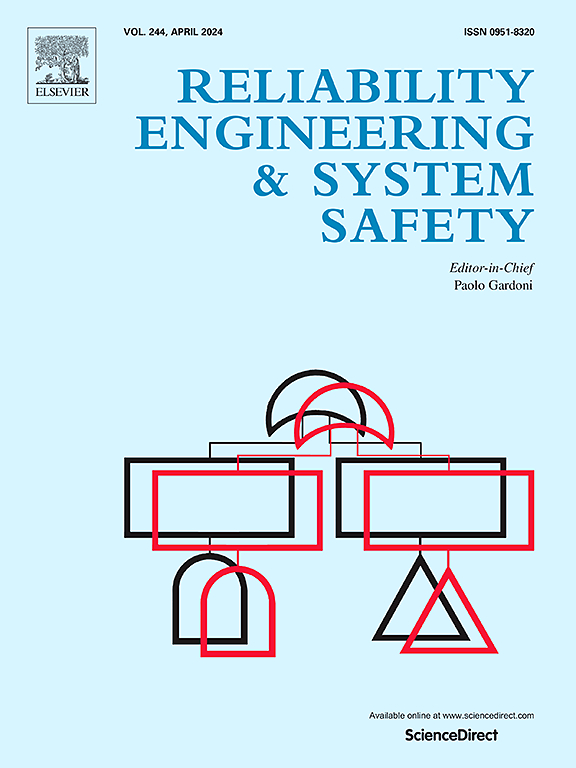Stochastic programming on joint optimization of redundancy design and condition-based maintenance for continuously degrading systems subject to uncertain usage stresses
IF 9.4
1区 工程技术
Q1 ENGINEERING, INDUSTRIAL
引用次数: 0
Abstract
This study investigates the joint optimization of system redundancy design and maintenance policies under uncertain usage stresses, using various stochastic programming models and stochastic-degradation-based reliability models. It is the first to address condition-based maintenance (CBM) policies, which outperform traditional age-based maintenance by reducing over- and tardy maintenance. Three two-stage stochastic programming models are developed. The first is a risk-neutral model aiming to minimize the expected system life-cycle cost across various usage stresses. The second is a risk-averse model using conditional value-at-risk to find solutions that perform well under the worst stresses. The third model also employs a risk-averse approach, using the upper partial mean to seek robust solutions for adverse stresses. The first-stage decision variables are subsystem redundancy levels, influencing CBM policies in the second stage. These CBM decisions depend on subsystem degradation levels and usage stresses. The long-run maintenance and failure cost rate is modeled as a recourse function, affecting redundancy allocation decisions. A numerical study demonstrates that the risk-averse strategies effectively mitigate the cost of worst scenarios without significantly increasing expected system life-cycle cost over all the scenarios. The redundancy level is high under a high risk aversion and can remain stable in a certain range of risk aversion. When the risk aversion is minor and the primary goal is the lowest expected lifetime-cycle cost, the redundancy design from risk-neutral model is preferred. The two risk-averse models would not generate the same redundancy design, no matter how to adjust the risk-averse parameters in the two models. Thus, the two risk-averse methods cannot be used exchangeable. The model using conditional value-at-risk is suitable for the cases where severe usage stresses could happen and the bad consequence cannot be tolerated. The model with upper partial mean is good for stabilizing the performances under all the adverse scenarios.
不确定使用应力下连续退化系统冗余设计与状态维护联合优化的随机规划
本文利用各种随机规划模型和基于随机退化的可靠性模型,研究了不确定使用压力下系统冗余设计和维护策略的联合优化问题。这是第一个解决基于状态的维护(CBM)政策的项目,该政策通过减少过度和延迟的维护,优于传统的基于年龄的维护。建立了三个两阶段随机规划模型。第一种是风险中性模型,旨在最小化各种使用压力下的预期系统生命周期成本。第二种是风险厌恶模型,使用条件风险值(conditional value-at-risk)找到在最坏压力下表现良好的解决方案。第三个模型还采用风险规避方法,使用上偏均值来寻求不利应力的稳健解决方案。第一阶段的决策变量是子系统冗余水平,影响第二阶段的CBM策略。这些CBM决策取决于子系统的退化程度和使用压力。将长期维护和故障成本率建模为一个追索权函数,影响冗余分配决策。数值研究表明,风险规避策略有效地降低了最坏情况下的成本,而不会显著增加所有情况下的预期系统生命周期成本。在风险厌恶程度高的情况下,冗余水平较高,并能在一定的风险厌恶范围内保持稳定。当风险厌恶程度较低,且主要目标是期望生命周期成本最低时,风险中性模型的冗余设计是首选的。无论如何调整两个风险规避模型中的风险规避参数,都不会产生相同的冗余设计。因此,这两种规避风险的方法不能互换使用。使用条件风险值的模型适用于可能发生严重使用压力和不能容忍不良后果的情况。具有上偏均值的模型能很好地稳定在各种不利情况下的性能。
本文章由计算机程序翻译,如有差异,请以英文原文为准。
求助全文
约1分钟内获得全文
求助全文
来源期刊

Reliability Engineering & System Safety
管理科学-工程:工业
CiteScore
15.20
自引率
39.50%
发文量
621
审稿时长
67 days
期刊介绍:
Elsevier publishes Reliability Engineering & System Safety in association with the European Safety and Reliability Association and the Safety Engineering and Risk Analysis Division. The international journal is devoted to developing and applying methods to enhance the safety and reliability of complex technological systems, like nuclear power plants, chemical plants, hazardous waste facilities, space systems, offshore and maritime systems, transportation systems, constructed infrastructure, and manufacturing plants. The journal normally publishes only articles that involve the analysis of substantive problems related to the reliability of complex systems or present techniques and/or theoretical results that have a discernable relationship to the solution of such problems. An important aim is to balance academic material and practical applications.
 求助内容:
求助内容: 应助结果提醒方式:
应助结果提醒方式:


